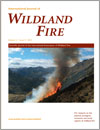International Journal of Wildland Fire
Volume 21
Number 4 2012
We mapped wildfire probability in the western United States using statistical models relating fire during a 25-year period to environmental variables representing ignitions, fuels, climate and topography. Results reveal highly heterogeneous patterns of wildfire probability and also enhance understanding of controls on wildfire activity in the western USA.
Spatial and temporal variation in seven fire regime variables are described for Canada’s managed forests. Opportunities for sharing forest fire suppression resources are explored with simulations of fire regimes and quantifying the degree of temporal and spatial synchrony in peak fire-activities.
Prediction of fires in British Columbia is a challenging proposition. We demonstrate significant year effects in logistic-type models for predicting fires and propose to use an ensemble of year-specific model predictions for computing a prediction with a confidence interval. Good results were achieved at the regional level.
We present a method for estimating spatial probabilities of burning as a function of fuels treatments for any wildland fire-affected landscape. Treatment effects within 14 large wildfires reduced average wildfire size by 7.2%, redistributing landscape fire risk such that fire risk was promoted in some areas and reduced in others.
Fire susceptibility models provide a quantitative understanding of the environmental controls of forest fires over the period 2003–07 in the Western Ghats of India. They allow identification of large fire-prone areas from the climatic conditions of the monsoon season before the fire season, and local vulnerable sites based on vegetation types.
We describe how burn probability changes with fuel age in Portugal. The time-dependency of hazard of burning is moderate. Larger fires and fires impelled by extreme weather conditions are associated to increased burn likelihood of young fuels but are also selective for older fuels. Fire management implications are discussed.
Management of Mediterranean-type shrublands frequently includes application of prescribed fire. This paper examines the use of fuel age (time since fire) and fire weather conditions to predict fire propagation and behaviour in 35 experimental fires in three shrubland types in Western Australia. Model predictions are evaluated against empirical observations.
Firebrand transport is studied for disc and cylindrical firebrands by modelling their trajectories with a coupled-physics fire model HIGRAD/FIRETEC. Simulations with eight firebrand models are performed to investigate the effect of firebrand shape, combustion, the terminal velocity assumption and fuel conditions. The coupled fire–atmosphere behaviour is critical to firebrand transport.
A two-phase method for modelling drying processes with initial moisture content above the fibre saturation point is proposed. Experimental results indicate that one type of two-phase model, namely a two-timelag model, yields consistent results in Scots pine fuelbeds with different structural characteristics that may improve fuel moisture modelling.
The objective of this study was to compare moisture of different size classes of fuels between unthinned and thinned stands. It has been suggested that thinning treatments reducing canopy cover might lead to greater drying of surface fuels; however, differences in fuel moisture between unthinned and thinned stands were minor and only occurred in the spring, before the main fire season.
We studied how fire severity and distance from unburned habitat affected small-mammal communities in southern California chaparral. Vegetation characteristics associated with post-fire recovery and other habitat features drove small-mammal responses, whereas distance and fire severity had few substantial effects.
We examined the immediate seed supply after a large wildfire by comparing soil seed bank and off-site seed rain. Although seed density did not differ between them, their species composition was markedly different, and these patterns were not affected either by fire severity or distance from the fire edge.
We used satellite images at spatial resolutions between 0.6 and 250 m to monitor vegetation recovery on vegetated linear dunes following wildfires in Western Australia. Although wildfires allow sand to be mobilised by wind, after just 1–5 years, vegetation recovers, limiting sand movement.




